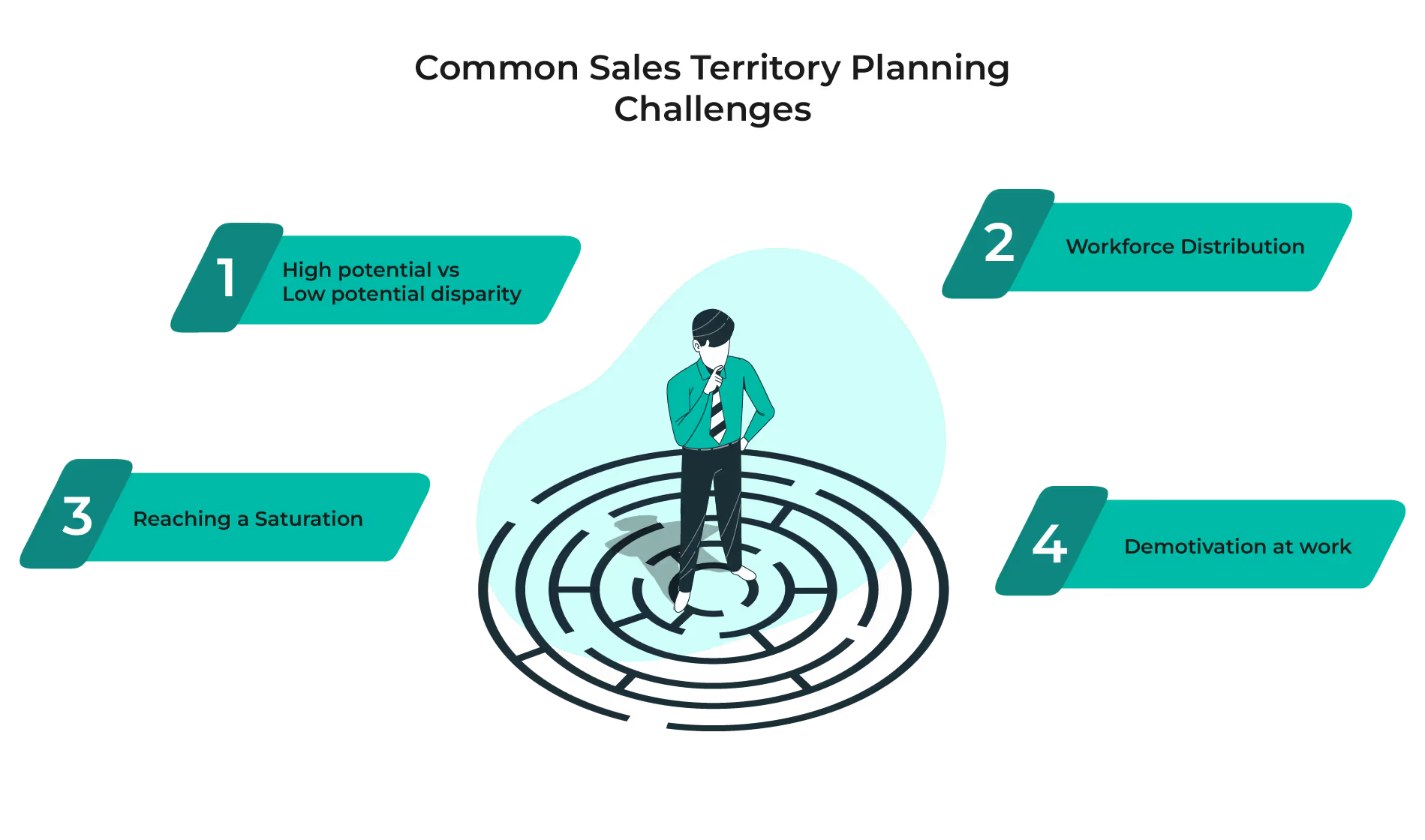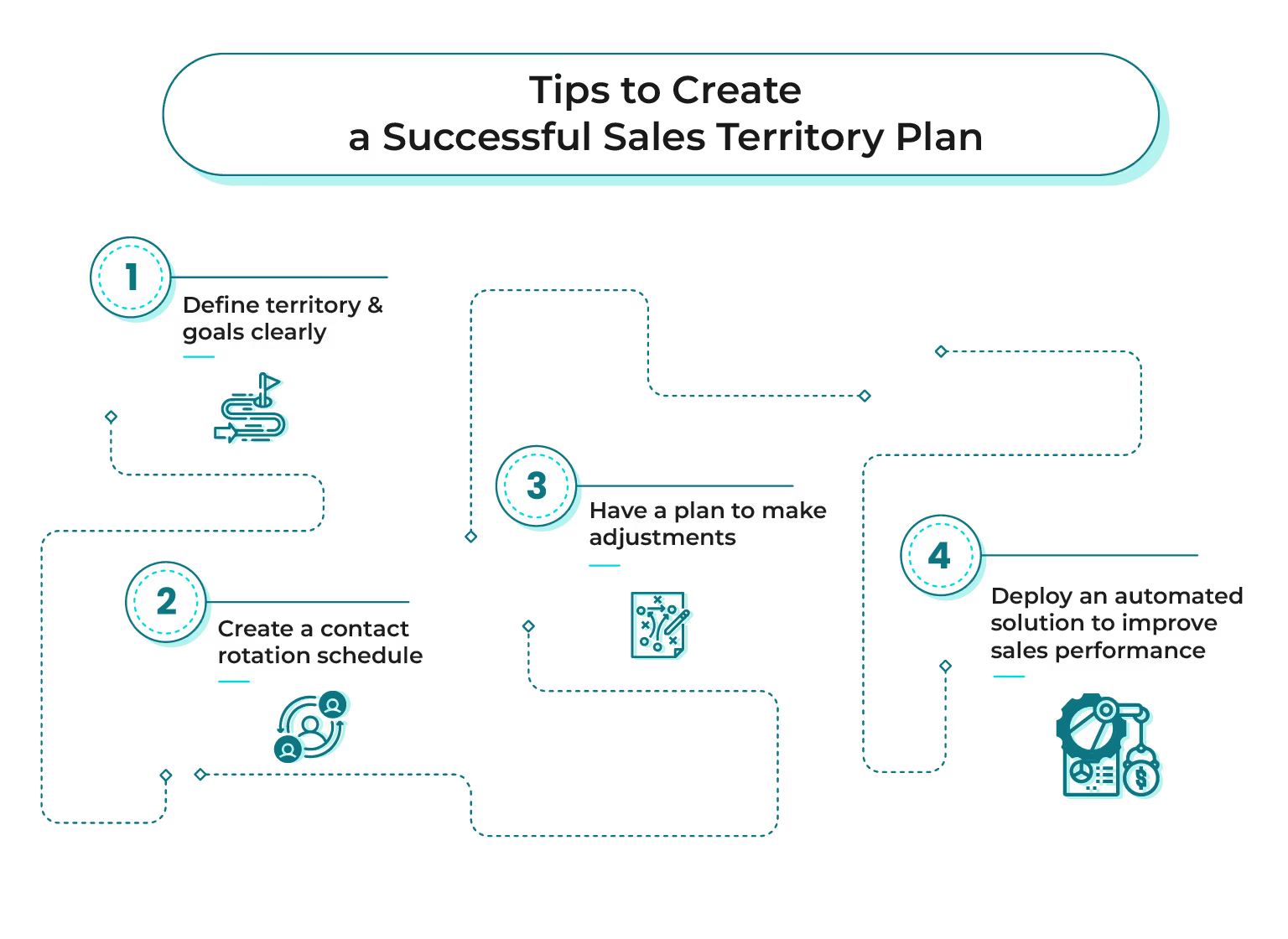
Blog
Essential Tips for Effective Sales Territory Planning
July 19, 2022


Key Insights
Many small and medium-sized businesses assume that having a sales territory plan is a complex suite that only giant corporations require to keep their large teams organized.
Such assumptions have led to companies, losing thousands and millions of dollars per year just because they fail to optimize their sales territory strategy. This not only results in wasted opportunities but also leads to high turnover as sales reps fail to support their individual financial goals.
So what exactly is Sales Territory Planning and why it should be a critical part of every business’ annual sales plan, including their Sales branding strategy? In this article, we’ll cover the following points:
What is Sales Territory Planning?
I’ll try to explain this phenomenon in the most simple way possible.
Take the example of a company selling Cloud Technology to restaurants: We all know that with social distancing being practiced all over the world, most independent restaurants, and food chains are pivoting to off-premises dining which would require them to have a robust online ordering system in place.
Now the companies offering the technology are racing to get the maximum number of restaurants under their belt and this would mean reaching out to even those businesses that are located in small counties and cities around the country.
Now imagine sending out a team of 5 field reps to a remote location (let’s say Hill County in Texas with a population of 30,000+) to sell the Online Ordering System to restaurants and similar businesses. With only a handful of restaurants and food trucks in the entire county, how many new customers do you think your team of 5 sales reps would be able to add?
In this scenario, if the reps fail to meet their on target pay annual targets, the company would have expended a substantial amount of resources merely to acquire a few new clients.
Sales territory planning is the process of strategically defining territories and assigning prospects to sales representatives to ensure an efficient and effective way of improving sales. By aligning territories with the sales pipeline funnel, sales reps can be given set goals and provided with the tools to help them hit their territory quotas at a higher rate.
Building a sales territory plan ensures that the efforts and resources of every sales representative are directed towards activities that provide them with equitable chances to earn incentives through well-designed sales incentive plans, including Incentive Compensation Plans, while the company optimizes its sales and profit.
Common sales territory planning challenges

Tips to create a successful sales territory plan:
- High potential vs Low potential disparity
Sales territory design is a crucial part of territory management, as a poorly executed plan can result in significant disparities. Assigning a sales rep to an area with high potential for the business can lead to a higher and easier conversion rate, while others may be assigned regions with low potential where despite great effort, lead generation remains a challenge, potentially resulting in a non-recoverable draw for those reps.
- Workforce Distribution
While assigning sales territory, the workforce must be distributed according to the potential of the region. If it's a high-potential area then organizations must assign more sales reps so that there is enough workforce to equally divide the labor, including prospecting, cold calling, sales campaigning, etc. In the lack of enough team members, salespeople will be overworked and unmotivated to carry out the job.
- Reaching A Saturation
If a sales rep has been working in the same territory for a very long time, there are chances that they reach a saturation point and lose their hunter mentality. Though there might be a large network they might have created over the years, there are chances that they feel satisfied and fall back on their achievements.
- Demotivation At Work
As mentioned above, when sales territory design is not proper it can have a great impact on the performance of sales reps. While a high-potential region motivates sales reps, a low-potential territory just puts off the sales reps. When how much effort they put in does not see light it affects their confidence, motivation, and drive to strive more.
Hence, while allocating territories among your team members, you must make sure that each rep gets an equal and fair opportunity to close deals and earn revenue for themselves, as well as the organization.

Factors that influence a good sales territory plan
Therefore, A good sales territory plan will resolve the challenges often faced during the process. Additionally, integrating technology such as a Sales Pipeline tool and leveraging b2b marketing automation examples can further streamline the sales process, ensuring that every territory is efficiently managed and optimized.
- A good sales territory plan ensures uniformity in revenue. When organizations do their territory design with precision, they will receive similar income for all the territories without a stark difference. Additionally, integrating technology and b2b marketing automation examples can further streamline the sales process, ensuring that every territory is efficiently managed and optimized.
- Organizations must ensure that during sales territory alignment they are also creating a platform where all their sales reps get equal opportunity to explore and utilize their potential as well as a fair game to bring in maximum revenue to the organization.
- Sales territory planning also calls for a close look at the market, its demands, the potential of your product/service in that territory, better customer planning and the availability of resources for the sales force to work up to their potential.
Tips to create a successful sales territory plan:

Define territories and goals clearly
This is the first and the most important stage of crafting a Sales Territory Plan. Focus on the who, where, when, and why to categorize and split your customers into various segments and subsequently define goals for each territory.
Most companies focus on geographic and industry-based clusters as it’s easier to acquire new customers from areas or industries with existing customers. Understanding your Total Addressable Market (TAM) will help you identify and segment prospective customers and companies by region.
When setting goals, look into the historical data, and forecast outcomes using the SWOT analysis. A SWOT analysis can help identify internal and external factors that can affect the performance of the territories as well as sales reps. This will allow you to focus on geography and demographics that are most likely to deliver results, rather than simply trying to cover the most ground.
Create a contact rotation schedule
When you are managing multiple sales teams looking after multiple territories, creating a contact rotation schedule can be the golden compass for ensuring everyone is pointed in the right direction.
It’s important to ensure that the prospects are provided with all the information and resources they need to move forward in their buying journey without feeling annoyed or overwhelmed.
Part of this step in the process is to determine when and how often a person in a particular territory needs a phone call, a scheduled visit, or a marketing promotion. You can use a CRM or a calendar to keep your schedule on track.
Have a plan to make adjustments
Keep in mind that any kind of change in the eco-system — from climatic to political, and perhaps, economical can have a great impact on the needs of your customers. Depending on the solutions you offer and the sales pattern over time, leave some room to make adjustments and changes to the goals for each territory if necessary.
The ultimate goal should be set to meet the changing needs of the territory or territories in a timely and effective manner. Make sure you measure progress and modify aspects of your territory strategy if you are unable to get the desired results.
Deploy an automated solution to improve sales performance
Sales Territory Management is a never-ending cycle of assessing, allocating, and adjusting goals and territories. It can be pretty easy to get lost in the ruckus of assigning tasks and tracking goals. However, to master territory management, you need to keep track of all the metrics in conjunction with sales quota and commission plans to gain a competitive advantage.
Deploying an automated system for territory alignment can help improve performance, reduce salesforce turnover, reduce time spent adjusting yearly changes, as well as ensure accurate account allocation, thereby efficiently achieving the objectives of the company.
Kennect supports your sales compensation plans by effective sales performance management
Kennect runs your sales compensation plan in cruise mode and automates your individual incentive and company compensation plan to create transparency & achieve operational efficiency.
ReKennect : Stay ahead of the curve!
Subscribe to our bi-weekly newsletter packed with latest trends and insights on incentives.
Thank you! Your submission has been received!
Oops! Something went wrong while submitting the form.
Your data is in safe hands. Check out our Privacy policy for more info















